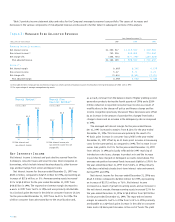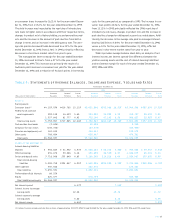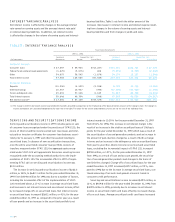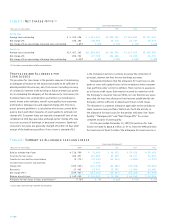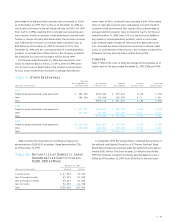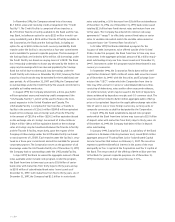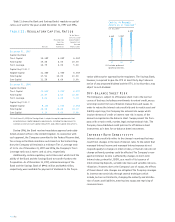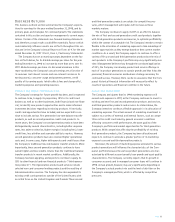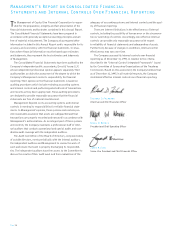Capital One 1997 Annual Report Download - page 34
Download and view the complete annual report
Please find page 34 of the 1997 Capital One annual report below. You can navigate through the pages in the report by either clicking on the pages listed below, or by using the keyword search tool below to find specific information within the annual report.
PAGE 32
Table 11 shows the Bank and Savings Bank’s regulatory capital
ratios as of and for the years ended December 31, 1997 and 1996.
Table 11: Regulatory Capital Ratios
To Be “Well-
Capitalized”
Minimum for Under Prompt
Capital Corrective
Adequacy Action
Ratios Purposes Provisions
December 31, 1997
Capital One Bank
Tier 1 Capital 10.49% 4.00% 6.00%
Total Capital 13.26 8.00 10.00
Tier 1 Leverage 10.75 4.00 5.00
Capital One, F.S.B. (1)
Tangible Capital 11.26% 1.50% 6.00%
Total Capital 17.91 12.00 10.00
Core Capital 11.26 8.00 5.00
December 31, 1996
Capital One Bank
Tier 1 Capital 11.61% 4.00% 6.00%
Total Capital 12.87 8.00 10.00
Tier 1 Leverage 9.04 4.00 5.00
Capital One, F.S.B. (1)
Tangible Capital 9.18% 1.50% 6.00%
Total Capital 16.29 12.00 10.00
Core Capital 9.18 8.00 5.00
(1) Until June 30, 1999, the Savings Bank is subject to capital requirements that
exceed minimum capital adequacy requirements, including the requirement to
maintain a minimum Core Capital ratio of 8% and a Total Capital ratio of 12%.
During 1996, the Bank received regulatory approval and estab-
lished a branch office in the United Kingdom. In connection with
such approval, the Company committed to the Federal Reserve that,
for so long as the Bank maintains such branch in the United King-
dom, the Company will maintain a minimum Tier 1 Leverage ratio
of 3.0%. As of December 31, 1997 and 1996, the Company’s Tier 1
Leverage ratio was 13.83% and 11.13%, respectively.
Additionally, certain regulatory restrictions exist which limit the
ability of the Bank and the Savings Bank to transfer funds to the
Corporation. As of December 31, 1997, retained earnings of the
Bank and the Savings Bank of $99.6 million and $24.8 million,
respectively, were available for payment of dividends to the Corpo-
ration without prior approval by the regulators.The Savings Bank,
however, is required to give the OTS at least thirty days’ advance
notice of any proposed dividend and the OTS, in its discretion, may
object to such dividend.
Off-Balance Sheet Risk
The Company is subject to off-balance sheet risk in the normal
course of business including commitments to extend credit, excess
servicing income from securitization transactions and swaps. In
order to reduce the interest rate sensitivity and to match asset and
liability repricings, the Company has entered into swaps which
involve elements of credit or interest rate risk in excess of the
amount recognized on the balance sheet. Swaps present the Com-
pany with certain credit, market, legal and operational risks.The
Company has established credit policies for off-balance sheet
instruments as it does for on-balance sheet instruments.
Interest Rate Sensitivity
Interest rate sensitivity refers to the change in earnings that may
result from changes in the level of interest rates.To the extent that
managed interest income and managed interest expense do not
respond equally to changes in interest rates, or that all rates do not
change uniformly, earnings could be affected.The Company’s man-
aged net interest income is affected by changes in short-term
interest rates, primarily LIBOR, as a result of its issuance of
interest-bearing deposits, variable rate loans and variable rate secu-
ritizations. However, due to the Company’s use of swaps, the effects
of these interest rate changes are mitigated.The Company manages
its interest rate sensitivity through several techniques which
include, but are not limited to, changing the maturity and distribu-
tion of assets and liabilities, entering into swaps and repricing of
consumer loans.
4.88%
Capital to Managed
Assets as of Year-end(1)
(in billions)
4.96%
6.03%
95 96 97
(1) Includes preferred
beneficial interests.


